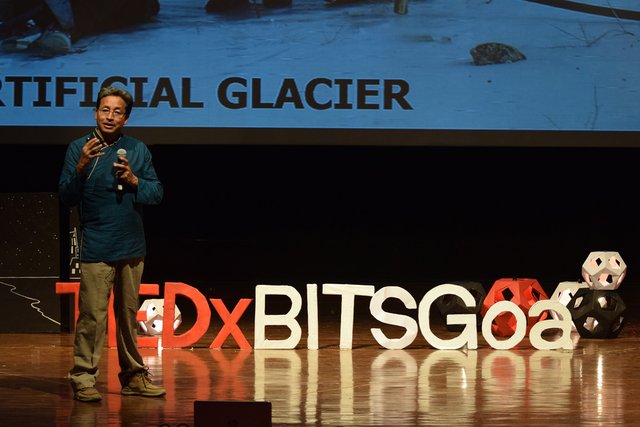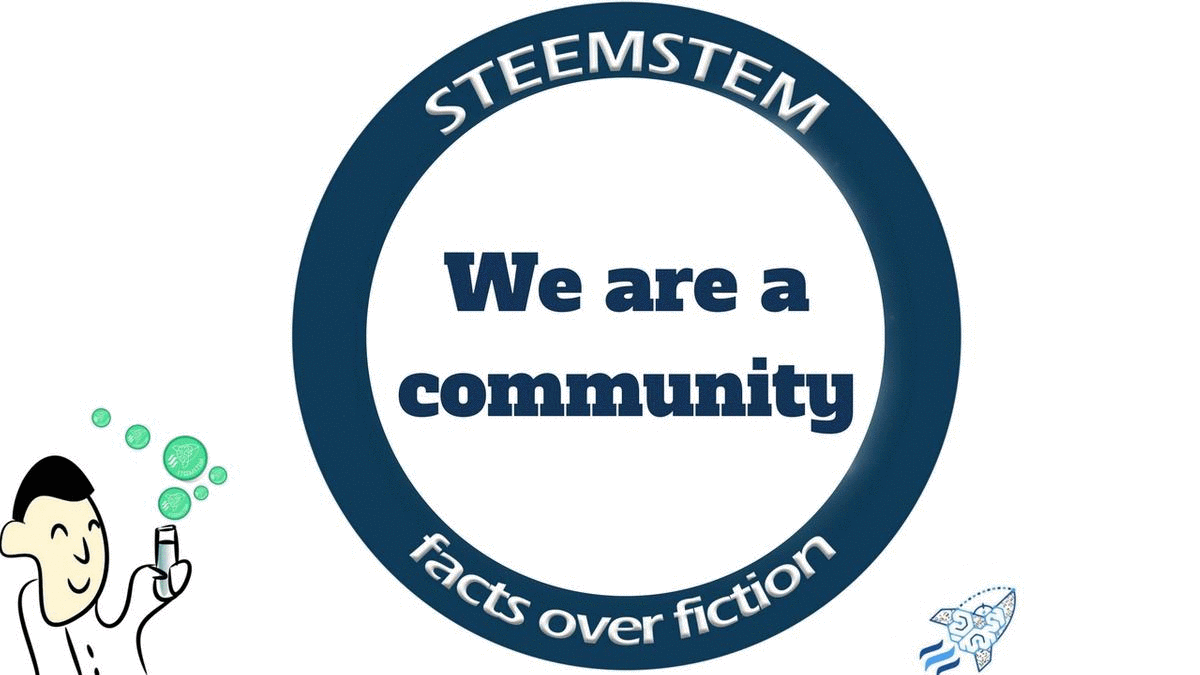TIL: Irrigating The Himalayan Desert Or... Ice Stupas
Up in the Himalayas where life is difficult and farmers struggle to find water for their crops, one man had a brilliant idea on how to solve the "water crisis".
One would think:
"Hey, what water crisis are we talking about? With so much snow and ice up there, one could easily get water for their fields"
This is not always possible. There is a period during April and May, when water supplies are scarce and the crops are left... thirsty. But thanks to the evolutionary idea of an engineer called Sonam Wangchuk there is now a way to make use of the glaciers and provide water to the area all year long.

Image from: flickr.com - Courtesy of: TEDxBITSGoa 2018 - License: CC BY 2.0
Do you want more details?
The cold desert of Ladakh (northern India) is located in the Himalayas where annual precipitation is low (around 100 mm/year). The area is inhabited by farmers, who keep their villages around glacial streams so as to take advantage of the water flow that feeds the Indus river. Villages are scattered in altitudes of 2,700 m to 4,000 m and rely on agriculture to survive. Their produce? Cereal, vegetables and fruit that get the valuable water from man-made canals tunneling the melt ice and snow towards the fields. [1, 2]
The water flow is not constant throughout the year since climate change has also had its effect on the Himalayan glaciers. As a result agriculture is "inactive" in wintertime (which crops would make it when temperatures drop as low as -30° C?). In winter there is a steady water flow that is of no use to the agriculture, in spring (especially from April through May) water is hard to find and in the summer temperatures rise and the glaciers start melting, sometimes even flooding the area. As one can imagine, this turns the farmers' life into a nightmare... [1, 2, 3]
Until Sonam Wangchuk came up with an idea!
He figured a way to provide a constant water supply all year long using nothing but a big pipe and... the force of gravity. Wangchuk piped glacier water from mountain streams and made an artificial glacier. He used pipelines to transfer water from glacier reservoirs in higher altitudes to the villages in lower altitudes. Imagine a long pipeline (sometimes as long as 60 meters or more) helping water out of a lake and ending in a vertical pipe further down outside a village. The pipe is then spraying water which, as it falls down, freezes and becomes a huge ice cone that looks like a buddhist temple (and that's where the name "stupa" came from). Gravity mostly powers the whole mechanism, which makes it an eco-friendly and low-cost way of building water reservoirs. The ice starts melting in springtime and provides farmers with the water they desperately need for their crops. The "supplies" will last until June (in some cases they made it to July), when the constant and "richer" flow will begin and the irrigation nightmare will be history. [5, 6]
Check this video to see how ice stupas work
Sonam Wangchuk began this project as an experiment inspired by another engineer's idea (Chewang Norphel tried to make huge blocks of ice in the mountains to use as water reservoirs, a venture that didn't prove as successful and efficient - source). The shape of the stupa is what makes it last through spring. Direct sunlight makes the ice melt, but the conic shape of the stupas allow for a smaller surface of ice to be exposed to the sun, hence making them last longer. [6]
The experiment took place in 2013, when 150,000 liters of water were frozen using a 2-meter high pipe. One year later, a larger pipe was built. In 2015, a crowdfunded pipeline of almost 2.5 kilometers was set up and provided the villages of the area with 1.5 million liters of water. Thanks to this in 2016 Wangchuk became the second Indian to win a Rolex Award for Enterprise for his innovative project. He also received a Rolex watch with his name engraved on and a money award as well. Wangchuk now aims to "expand" his project by building 50 more pipes and put this money in good use. Although there is something else on his list: to figure out a way to prevent the overflow of glacial meltwater that floods the areas in summer (a phenomenon knows as glacial lake outburst floods or GLOF). [5, 6]
The all-in-one package
Other than a sigh of relief to the farmers of the desert, the ice stupas could bring a boost in the local tourist industry as well. The inside of the stupas are big frozen igloo-like caves, covered in plastic (as insulating material). They serve as the "command center" where the team can determine the height of the cone and the water flow. Once the construction is completed, the caves could be rented to tourists that seek holiday accommodations out of the ordinary. [6]
Ice stupas are an excellent example of creativity, adjustability and how one can turn a disadvantage to a boon. Thanks to Wangchuk the area might not need to be deserted in the decades to come; if the young people learn how to take advantage of such techniques and keep the local economy alive, they will not have to seek their future elsewhere. Another project that he is on since 1988 is the "Students’ Educational and Cultural Movement of Ladakh" (SECMOL), an alternative school for students who fail in the school board exams. SECMOL functions using green practices and as described in the official site it "is not a conventional school, but a place to pursue practical, environmental, social and traditional knowledge, values and skills". [6]
And if you want to see how the locals feel about this brilliant invention of ice stupas, watch this one!
PS: Unfortunately there were no free images to use in this post, so I will have to leave you with those youtube videos. You can always go through the reference links for more details and pictures if you like.
References
[1] icestupa.org
[2] nationalgeographic.com
[3] wikipedia.org
[4] atlasofthefuture.org
[5] independent.co.uk
[6] thewire.in

Thank you so much for your time!
Until my next post,
Steem on and keep smiling, people!


Great post @ruth-girl. Water problem is becoming worst in most of the countries and it is good to know that at least people are working to solve it.
Thank you @munawar1235!
Reading more about Wangchuk and his work with the people and the resources available in his area has only made me look up to him and his persistence and dedication to keep that place alive.
It's certainly a nice idea. The thing is that sometimes, we, humans, don't see the forest from the tree.
Here are two videos which should be regarded in relation to each other (as an example of the above):
combined with the following:
Just just food for thought.
Oh! I admit this was something I had never thought about...
And unfortunately learning to see the bigger picture is not something we are taught (trained should be a more fitting word). Thanks for the extra "brain snack" :P
(Yes, trained is a better word indeed.)
My pleasure! :D
I had similar thoughts when reading the article, that maybe they're upsetting some kind of natural balance that's needed for something else 'downstream' to work properly. ... But the thing is, the balance was already upset by human-caused climate change: the farmers used to have all the water they needed. ... But yeah, tough to predict these things and to know good from bad.
Hi @ruth-girl!
Your post was upvoted by utopian.io in cooperation with steemstem - supporting knowledge, innovation and technological advancement on the Steem Blockchain.
Contribute to Open Source with utopian.io
Learn how to contribute on our website and join the new open source economy.
Want to chat? Join the Utopian Community on Discord https://discord.gg/h52nFrV
I've never heard of the Ice Stupas before, but I must confess; this is the height of creativity and ingenuity.
You see; the solution to almost every challenge is not too far away from the challenge itself.
Nice piece Ruthie
I mostly admired the engineer. He has done so much trying to help these people. And what is even more exciting is the fact that he wants the young people to stay and "fight" with what they got instead of fleeing away.
Thank you Sammy! :)
What an amazing idea, and it is so cool to witness it actually work!
Guys like him should be given by governing bodies a serious budget to develop these initiatives even further.
Admirable, he is certainly admirable!
I agree he should be funded by the government, it's too bad to hear that such ventures rely on crowdfunding.
Hello @ruth-girl
Welcome to the new week and I trust your weekend was joyous.
To this technological invention, I should say that's ingenuity at play, thanks to Sonam Wangchuk. Most of worlds inventions were thought out under great challenge. Those who don't face difficulty hardly think but when a man is pressed, he has to find a way. And most at times, finding that way leads to invention.
Regards
@eurogee of @euronation and @steemstem communities
Hello @eurogee! This man was an excellent example of how to make do with very little resources and never give up when you really want to help people. He is an amazing figure.
Thanks for stopping by! :D
Shows that we don’t always need advanced technology to make a lot happen in science and engineering. Sometimes just a big pipe and a good idea is enough!
That's right! Sometimes the solution is so simple and all it takes is a man to make it work :)
Besides their obvious benefits, These ice stupas look really cool ! Not always complex problems need complex solutions, sometimes the answer is very simple ! Great post !!
Thanks @fancybrothers! Sometimes simple works better and when you come to think that people there have to make do with very little resources, creativity has to take over :)
It's a creative idea....Not only in hilly areas but also in plain areas now a days water table is falling..most of the places people find difficulty for clean drinking water.
If we do not think of water conservation and it's proper management....we should be ready for third world war and the reason will be drinking water!!!
We need more ideas like that to get a lot of problems sorted out easily and with low costs.